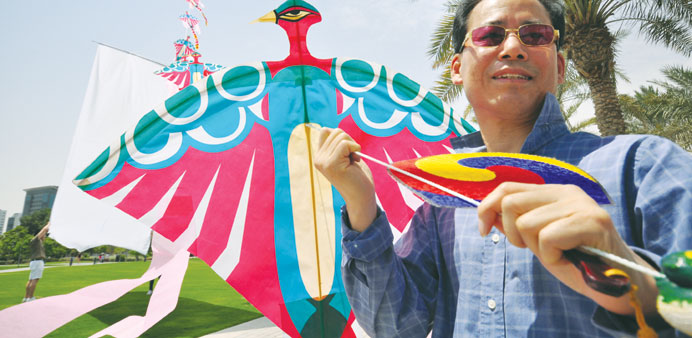|
The ancient craft of kite making in Korea is a tradition passed on from generation to generation – a skill that is considered essential since Koreans fly traditional kites on the 15th day of each lunar year to “blow away” misfortune and consequently, “call in” good luck. |
But for consul Bumil Park of the South Korean embassy Qatar, this has not been the case.
“I did not get the chance to fly a kite. I do not think my grandfather had taught my father how to build a kite,” said Park with a seemingly sheepish smile when Gulf Times asked if he had flown a kite as a child.
The Korean consul was at the Museum of Islamic Art Park yesterday to facilitate the staging of the “Magnificent Korean Kite-flying Event,” which concludes today at the Katara-Esplanade.
What Park missed out as a child in Korea, he is making up in Qatar as the consul marks the event as his first time to fly a Korean kite. And Park selected the majestic and colourful “Phoenix” train kite for his debut.
The Phoenix, which spans 800m in length, is made up of 130 kites stacked on top of each other. Separated by a distance of about 3ft each, the kites are adorned by traditional Korean cultural icons and designs.
“I’m a very lucky guy! While I did not fly a kite in my home country, today I have the chance to fly my very first kite,” Park said.
The consul also noted the significance of his first attempt at kite flying: “Today means a lot to me. Not only because it will be my first time [to fly a kite] but more importantly, I will experience the joy of kite flying on the 40th anniversary of diplomatic relations between my country and the State of Qatar,” Park shared.
According to Park, he checked the day’s weather forecast early in the morning to see if the winds would be ideal for kite flying. “Wind speed should at least be from 3kph to 5kph, and today is a good day to fly a kite,” he said. Indeed, it was.
With the Phoenix in hand, Park looked up towards the blue Qatar sky and smiled. Though he seemed blinded by the sun, Park was oblivious and has come full circle with one of Korea’s longstanding cultural traditions.

